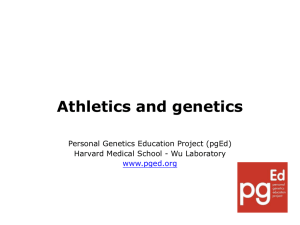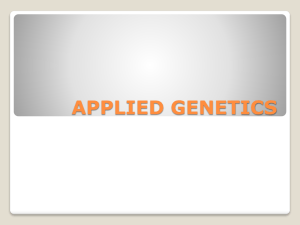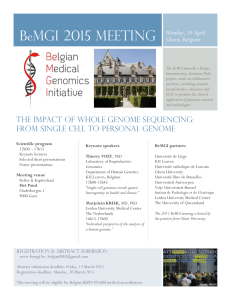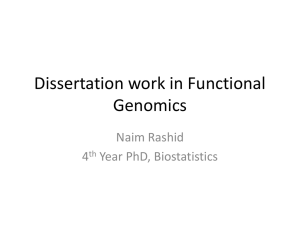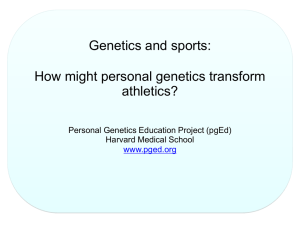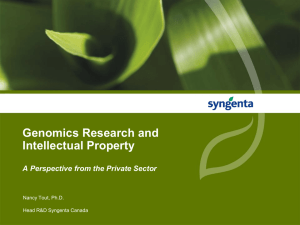Genetic and Genomic
advertisement
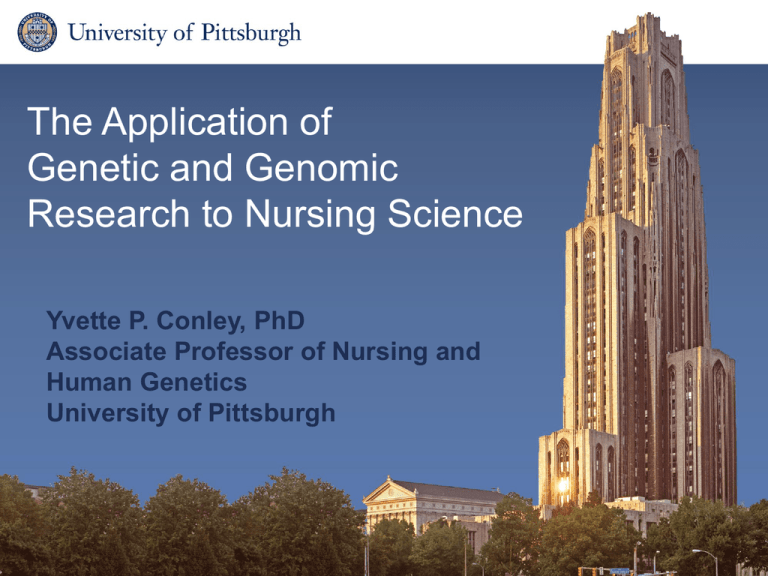
The Application of Genetic and Genomic Research to Nursing Science Yvette P. Conley, PhD Associate Professor of Nursing and Human Genetics University of Pittsburgh Discussion Today… Some background Genetic/Genomic research approaches and tips for integration into your research Resources of interest There is support The field of genetics has changed… In the past … Our primary concern was determining what gene and mutations caused single gene disorders that had predictable inheritance patterns (eg CF, SCA, PKU) The field of genetics has changed… Now… Much of our focus is on more common, complex conditions, those of great public health concern, variability in patient experiences including symptoms, and patient outcome related phenotypes Now… Much more complex way of looking at genetics/genomics, for example: – Gene Gene interactions – Gene Environment interactions – Individualized therapies Genetic…Genomic? Genetics is used when referring to a single gene Genomics is used when referring to the whole genome, multiple genes, gene-gene interaction Genomic Translational Research Khoury MJ et al (2007) Genetics in Medicine, 9(10):665-674 Khoury MJ et al (2012) Am J Public Health 102(1):34-37 Frequently Utilized Approaches to Genetic and Genomic Research Association – Case/control – Family – Genome wide association studies (GWAS) Gene Expression Epigentics/Epigenomics Candidate Gene Association Studies A candidate gene association study is used when you have an educated guess about a genes involvement in the condition you’re investigating Can use unrelated individuals or families advantage is ability to use unrelated individuals particularly if studying a complex or age-related condition, as well as phenotypes within the context of an external event – such as recovery after injury, symptoms within the context of an illness, etc. Association studies Usually uses a case/control design and the cases are compared to the controls to determine if genetic variability differs significantly between them, potentially indicating that the gene that houses that variability is involved with that condition Requires some knowledge of the biology of the condition in order to select appropriate genes to investigate – potential disadvantage what if we don’t know much…or think we know but are not on right track Can take confounding data, such as environmental exposures, into consideration Selection of appropriate control group very important Genome Wide Association Studies A Genome Wide Association Study (GWAS) is used when you want to investigate the entire genome to determine what polymorphisms are associated with the condition you’re studying One advantage is the biology of the condition does not need to be well understood. You investigate the entire genome and see where the data takes you One disadvantage is the large number of subjects required Genome Wide Association Studies The usefulness of GWAS has sparked a call for GWAS data to be placed into large databanks for investigators to mine for association with a variety of characteristics (NIH data sharing plan) Visit http://www.ncbi.nlm.nih.gov/WGA for updates on what cohorts have agreed to have their data made available Genome Wide Association Studies archive and distribute the results of studies that have investigated the interaction of genotype and phenotype dbGaP: Framingham Heart Study Study Participants Entire study 14276 Cancer 3373 Diabetes 6071 MMSE 6256 Menopause data 5360 CRP 8287 Inflammatory Markers >7000 for most dbGaP: Framingham Heart Study Study Participants Pulmonary function test 9007 SF-36 2952 Hormone data 3925 Abdominal fat study 3384 Brain MRI 2727 Cardiac CT scans 3518 dbGaP: Framingham Heart Study Study Participants Dementia 2715 Digital ECG 11828 Echocardiography 4079 Bone density 4728 Plasma Renin 3352 Osteoarthritis study 1333 dbGaP: Other studies in db Study Collaborative study of psoriasis Multicenter ADHD project GWAS of Schizophrenia Major Depression Diabetic Nephropathy in type I diabetes Participants 2875 2835 5066 3741 1825 dbGaP: Other studies in db Study Participants WGAS of Bipolar Disorder 2160 Whole Genome Association Study of Visceral Adiposity in the HABC Study 2802 LEAPS study* 1550 AREDS Multiple releases 4757 * Linked Efforts to Accelerate Parkinson’s Solutions collaboration dbGaP: Other studies in db Study Participants NINDS Parkinsonism study 1283 NINDS Parkinson’s 535 NINDS repository of neurologically normal control collection 2723 Dental Caries GWAS 5291 High Density SNP Association Analysis of Melanoma 3115 dbGaP: Other studies in db Study Participants FUSION study* 1283 GENEVA Diabetes Study (NHS/HPFS) 6033 Women's Health Initiative SHARe 12,008 Preterm birth 1029 Health and Retirement Study 12,507 * Finland-United States Investigation of NIDDM Expression Analysis Expression analysis is used when you suspect that variable amounts or variable forms (alternative splicing/isoform) of a gene product is playing a role in the condition you’re studying remember genemRNAprotein Gene expression can be assessed at the protein or mRNA level Potential disadvantages usually need to extract from tissue of interest and stability of sample may be an issue Frequently uses “microarray” technology to assess all known genes simultaneously If using relative gene expression changes then how you’ll compare subjects/groups is important Epigenetic/Epigenomic Epigenetic/Epigenomic analysis is used when you suspect that gene regulation may be implicated in a condition of interest – Candidate gene/gene region epigenetic – Multiple genes/whole genome epigenomic involves looking at modifications that do not involve the nucleotide bases of DNA but instead look at things like chemical modifications (such as DNA methylation) or packaging of the DNA Epigenetic/epigenomic modifications are dynamic and responsive to environment (endogenous and exogenous) Advantage uses DNA as template and DNA is stable, so may be more amenable approach for stored samples Disadvantage tissue specificity Strategies to incorporate genomics into your research trajectories Collect samples and bank them for future use – Broadly written informed consent to cover future investigations Tap into existing samples/data to investigate your research questions be mindful of how samples stored and how that may impact utility for a particular approach Collaborate – you may be interested in a phenotype that someone with samples may not have considered Visit and Exploit online resources as much as possible The techniques to collect and analyze genetic/genomic data advances rapidly – keep yourself informed Funding is favorable, often viewed as innovative to add a genetic/genomic component NINR Strategic Plan To advance the science of health, NINR will invest in research to: Enhance health promotion and disease prevention Improving Quality of Life by managing symptoms of acute and chronic illness Improve palliative and end-of-life care Enhance innovation in science and practice Develop the next generation of nurse scientists www.ninr.nih.gov/AboutNINR Enhance health promotion and disease prevention Biology and Behavior are important factors – Biology often impacts behavior and behavior often impacts biology incorporating both into research trajectories focusing on health promotion and disease prevention makes sense “…evaluate health risks in diverse communities by exploring the multiple factors that underlie susceptibility and mediate risk for developing disease and illness …” “…the development of innovative interventions tailored to the individual will improve health behaviors, decrease the incidence of acute and chronic illness, and advance health outcomes while reducing health care costs…” Improve Quality of Life by Managing Symptoms of Acute and Chronic Illness Not all patients will experience symptoms or experience them to the same extent this variability may at least in part be due to genetic variability, this is also true of their caregivers Variability in response and adherence to interventions (including behavioral) may at least in part be due to genetic variability “NINR will invest in basic, clinical, and translational research that: Improves knowledge of biological and genomic mechanisms associated with symptoms and symptom clusters” “NINR will invest in basic, clinical, and translational research that: Studies the multiple factors that influence the management of symptoms and applies this knowledge to the design of personalized interventions” Improve Palliative and End-ofLife Care Adequate management of pain, fatigue and depression require understanding mechanisms and variability in response End-of-Life experiences of patients with genetic conditions End-of-Life issues confronted by family members of people with genetic conditions keeping in mind that genetic conditions are different, family members might face same disease or have been spared Enhance Innovation in Science and Practice “Rapid advances in technology and genomic science, as well as significant changes in demographics and health care policies and practice, have placed pressing demands on nursing to find fresh approaches and interventions that improve health outcomes” “The frontier of technology holds great promise for advances in health care. For example, NINR will continue to develop and refine the application of genetic and genomic science to improve risk assessment and identify potential interventions” Develop the Next Generation of Nurse Scientists Summer Genetics Institute – Summer 2013 will be 14th year of training – over 240 alumni – SGI “express” Individual Training Grants (mostly F31s) with “genetic” as a key word: n=49 separate grants funded as of April 9, 2013 Funding for Genetics/Genomics by the NINR As of April 2013, the NINR has funded 111 extramural research grants (R’s, K’s, P’s) that have a genetic or genomic theme to the objectives of the projects based on data obtained from NIH RePORTER Compared to May 2010, when the NINR had funded 73 extramural grants that had a genetic or genomic theme to their objectives (38 in past 3 years) Funding for Genetics/Genomics by the NINR Since 1/1/2000 the NINR has participated in 271 Request for Applications (RFA) or Parent Announcements (PA) that have genetics or genomics listed within the purpose, objectives, or potential approaches Since 1/1/2000 the NINR has been the issuing organization for 89 Request for Applications (RFA) or Parent Announcements (PA) that have genetics or genomics listed within the purpose, objectives, or potential approaches Funding for Genetics/Genomics by the NINR Exemplars of recent RFAs: 2010: RFA-NR-10-004 (R01) and RFA-NR-10005 (R21) focused on “Epigenetic Factors Associated with Symptoms and Complications of Chronic Disorders” 2011:RFA-NR-11-003 (R01) and RFA-NR-11-004 (R21) focused on “Personalized Genomics for Symptom Management: Bridging the Gaps from Genomic Discovery to Improved Health Outcomes” 2012: RFA-NR-12-002 (R01) and RFA-NR-12003 (R21) focused on “Application of Genomic Advances to Wound Repair” Funding for Genetics/Genomics by the NINR Exemplars of recent RFAs: RFA-NR-12-010 focuses on “Early Detection and Prevention of Mild Cognitive Impairment (R01)”…”Utilization of biomarker or genetic information to examine similarities and differences in MCI and its sequelae among those diagnosed with LLI and appropriate controls” RFA-NR-12-006 (P30) and RFA-NR-12-009 (P20) focuses on “Centers of Excellence in Symptom Science”…”increase the quantity and quality of research projects utilizing, genetics/genomics, and biobehavioral methods” Funding for Genetics/Genomics by the NINR Exemplar current RFA: due May 9, 2013 RFA-NR-13-002 (R01) and RFA-NR-13-003 (R21) focuses on “The Influence of the Microbiome on Preterm Labor and Delivery”…”Genomic and epigenomic variants that potentially interact or associate with the microbiome in predisposing women to preterm labor and delivery” Useful Web Sites www.ncbi.nlm.nih.gov – Has pull down menu that includes OMIM – Online Mendelian Inheritance in Man, databases on genomic variations (eg. SNP), dbGaP, and much more www.isong.org – International Society of Nurses in Genetics www.ons.org – Oncology Nursing Society – has many tools including online modules for nurses to learn more about genetics www.cdc.gov/genomics – National Office of Public Health Genomics – Can sign up for weekly updates via email Useful Current/Upcoming Literature Most recent issue (March 2013) of Journal of Nursing Scholarship focused on genetics/genomics particularly where we are with evidence and translation to practice 2012 issue of Annual Review of Nursing Research was focused on genetics/genomics Throughout 2011 the Journal of Nursing Scholarship had a series of articles that focused on Genetics and Genomics in Nursing with particular focus on educating nursing faculty, nursing students, and patients In Summary Focus has shifted from rare single gene conditions to common, complex disorders of major public health concern and towards understanding patient experiences/outcomes Mainstreaming of genetics/genomics Like many disciplines, translation of research is an issue Nurses are well poised to address many of these transitional arenas and many nurses ARE addressing these arenas Incorporating genetics/genomics using suitable approaches is appropriate for most programs of research The next generation of Nurse Scientists will have excellent representation of genetics/genomics The NINR supports genetic/genomic research/training
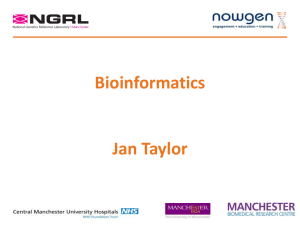
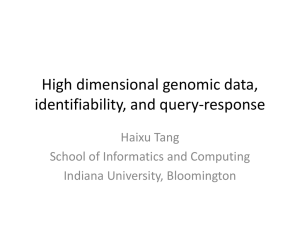
![9_Komlenac - start [kondor.etf.rs]](http://s2.studylib.net/store/data/005352037_1-bdc91b0717c49a75493200bca431c59c-300x300.png)
